
National Institute for Basic Biology




| Organizers | Kiyoshi Naruse (NIBB and NBRP Medaka) Akihiko Kashiwagi (Hiroshima Univ. and NBRP Xenopus) Christoph Winkler (NUS) Yasuhiro Kamei (NIBB) |
|---|---|
| Venue | National Institute for Basic Biology (NIBB), Okazaki, Japan |
| Date | Sep. 22–Oct. 1, 2014 |
| Link | Web site (http://www.nibb.ac.jp/course8/) |
| Poster |
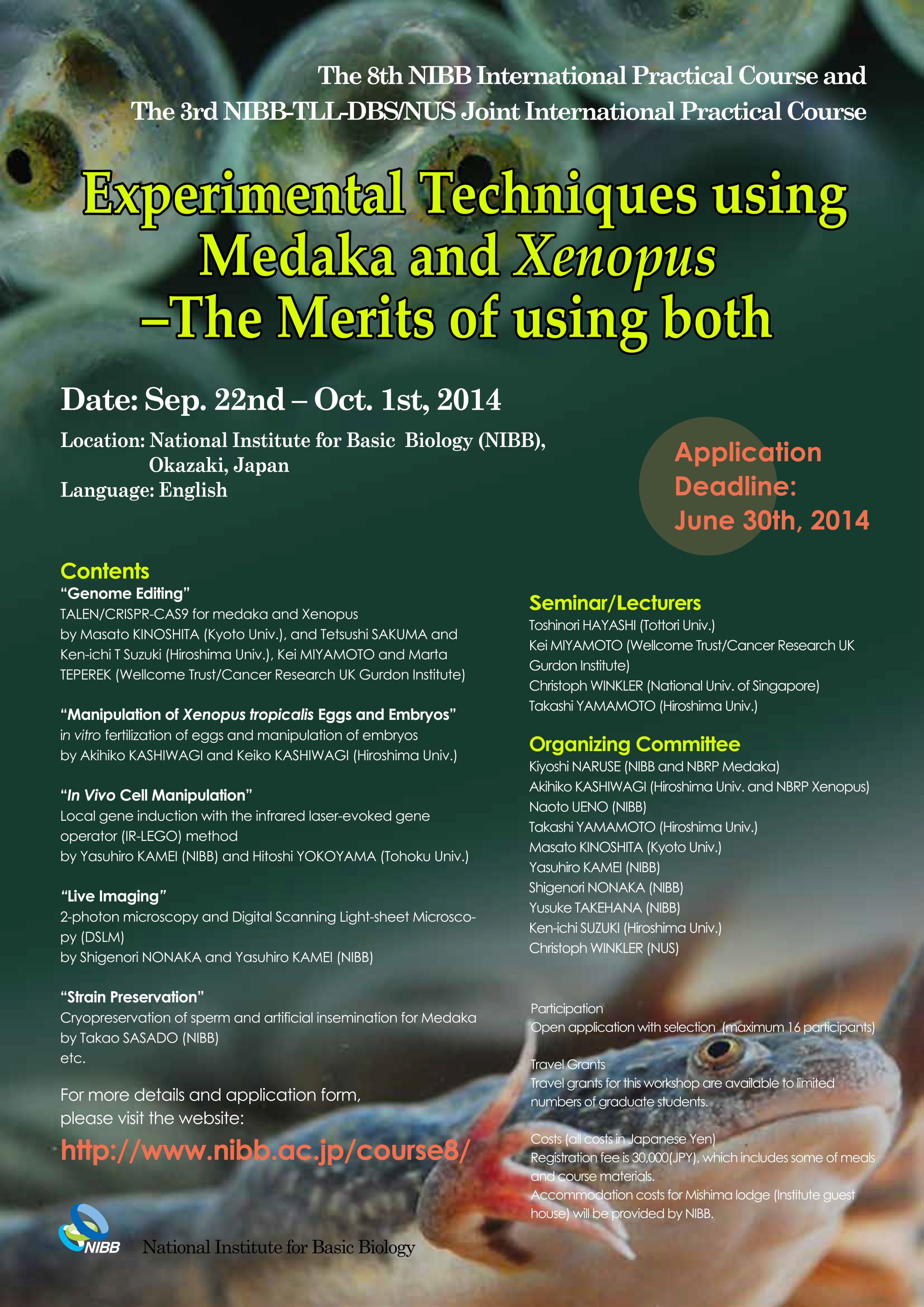
|

The 8th NIBB International Practical Course & The 3rd NIBB-TLL-DBS / NUS Joint International Practical Course "Experimental Techniques using Medaka and Xenopus - The Merits of using both -" was held from September 22 to October 1st 2014. This course was held at the National Institute for Basic Biology in response to the 2nd NIBB-TLL-DBS / NUS Joint International Practical Course that was successfully conducted at the National University of Singapore. Participants were assembled through an international public offering. As a result, from among the 29 applicants 16 participants from Taiwan, Hong Kong, India, Indonesia, Bangladesh, Germany, the United States, and Japan were selected. Travel expenses were supported for graduate student participants. On the other hand, researchers who participated from developing countries had a fairly large economic burden. Going forward we might need a support system for consideration of the economic status of the country of origin, not only the distinction between researchers and graduate-students.
Unique Features of this NIBB International Practical Course were, training with medaka and zebrafish, and also training with Xenopus. Through these workshops connections were made between the two communities of small fish and Xenopus researchers, the course was planned with the intention that participants should experience research using a variety of experimental systems. In addition to the main project aims, there was also the sub-aim of displaying the rapid development of genome editing technology (such as mutants created by TALEN and CRISRPR-CAS9), which can be used in Xenopus and small fish. This technology has been called a "technological-revolution" because the technology is allowing easy production of mutants and transgenic lines in organisms, in which conventional genetic analyses are difficult to carry out. In response to these changes in the research environment and technology, participants were allowed to use both medaka and Xenopus not only in live-imaging using 2-photon microscopy and light sheet microscopes, and training in important sperm freezing technologies for long-term storage of mutants, but also in the TALEN / CRISRPR-CAS9 genome editing system to produce knock-out and knock-in mutants, and the gene induction system by IR-LEGO. The results of the questionnaire show the course was very popular to those who participated. In addition to the standard training schedule, on every day except Sunday and on the last day, distinguished invited researchers in the field conducted seminars for participants.
The contents of the seminars were, ‘Understanding the underlying mechanism of seasonal time measurement using various vertebrate species’, ‘Live imaging of osteoblast-osteoclast interaction during bone resorption and regeneration in a medaka osteoporosis model’, ‘Transcriptional Reprogramming of Sperm and Somatic Nuclei in Xenopus Laevis Oocytes and Eggs’, ‘Targeted Genome Editing with CRISPR/Cas9 via Homology Directed Repair’, ‘Development of IR laser-mediated gene induction system, and applications to medaka and other species’, ‘Neural mechanism of socially-regulated female mating preference in medaka fish’, ‘Application of Gene Manipulation Systems to Study Three-dimensional Organ Regeneration in an Amphibian, Xenopus laevis’, ‘Application of Gene Manipulation Systems to Study Three-dimensional Organ Regeneration in an Amphibian, Xenopus laevis’, and ‘Introduction of Iberian ribbed newt (Pleurodeles waltl) as a useful model animal for basic biology’. The seminars were extremely interesting because of both the cutting–edge research using small fish and amphibians, and the research using multiple model organisms concurrently.
The Office of International Cooperation took a leading role in ensuring that participants from the Muslim world and others with restrictive diets had plenty of variety to choose from during meals, delivering a hospitable atmosphere for all. Since the day-to-day diet is an important aspect to the participants of the workshop, I want to take this opportunity to dedicate a big thank you to the staff of the Office of International Cooperation for playing this part. I would also like to thank the research groups that were co-sponsors of the course: National BioResource Projects (NBRP) Medaka, NBRP Xenopus, Molecular Mechanisms Underlying Reconstruction of 3D Structures During Regeneration (supported by MEXT, Japan), and Enhancing Application of Innovative Optical Science and Technology by making Ultimate Use of Advanced Light Sources (supported by CREST/JST, Japan). Finally I would like to thank the staff in the Institute for Amphibian Biology, Hiroshima University, the Laboratory of BioResources, NIBB, and the Spectrography and Bioimaging Facility, NIBB, whose preparations made this training course possible.
Kiyoshi Naruse (NIBB and NBRP Medaka)
It has been about 1 month since the end of the "8th NIBB International Practical Course & The 3rd NIBB-TLL-DBS / NUS Joint International Practical Course "Experimental Techniques using Medaka and Xenopus - The Merits of using both -", and the climate is heading into late autumn. As for me, during the term of the course, from late September to early October, I had to somehow juggle my overcrowded schedule every day, and I hardly had time to think. At last now I can look back, and I keenly feel the importance of this event and its significance and the importance of the unity of our efforts.
The inspiration for this course came last year during the 84th Zoological Society of Japan Meeting in Okayama when Professor Naruse approached me with a smiling face and asked if it might be possible to hold a joint NBRP Medaka and NBRP Xenopus training course next year. Because Dr. Naruse has poured so much of his energy into NBRP Medaka, and because this proposal came from a researcher with whom I share a deep trust, I immediately agreed.
Applications were reviewed and participants were selected. The young researchers who were chosen all displayed passion, and a sincere attitude towards science and their specializations. During the training course the lecturers, and also laboratory staff, could see and feel the extraordinary levels of concentration and enthusiasm showed by the participants, which furthermore increased the staff’s excitement. But this was transformed during the farewell party on the last day. Everyone present felt a clear sense of relief that everything was successfully finished. The young participants learned a lot about experimental techniques using Medaka and Xenopus, and the seeds of friendships crossing international borders certainly sprouted. Impressions of Japan, and more specifically, of NIBB, were no doubt inscribed deeply in their minds. I am very much looking forward to seeing how each of them grows and contributes to the development of science in the future.
Surely many of the applicants who were not chosen felt their hopes were dashed. If we are focusing our outlook on international contributions, our selection criteria in the future should perhaps place more consideration on the state of the country or nation in which the applicant resides.
I will never forget that it was thanks to the efforts of the many staff members that the event concluded so successfully.
Akihiko Kashiwagi (Hiroshima University and NBRP Xenopus)


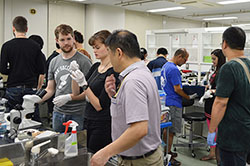



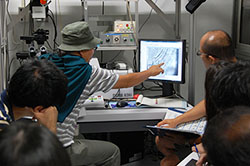
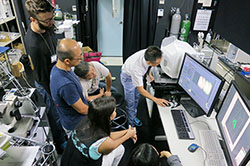
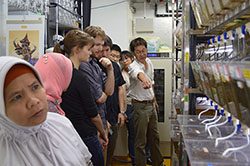

| Mon, September 22nd, 2014 |
| 14:00 - 16:00 Arrival and Registration |
| 16:00 - 16:30 Opening Remarks & Orientation |
| 16:30 - 17:30 Seminar by Dr. Yoshimura, Takashi (Nagoya Univ./NIBB) |
| 18:00 - 20:00 Welcome Party |
| Tue, September 23rd, 2014 |
| 09:00 - 10:00 Outline for procedure of TALEN by Dr. Sakuma |
| 10:00 - 10:30 Outline for Xenopus manipulation by Drs. Suzuki, Miyamoto and Teperek |
| 10:30 - 12:00 Manipulation of Xenopus embryo |
| 13:00 - 16:30 Manipulation of Xenopus embryo |
| 16:30 - 17:30 Seminar by Dr. Winkler, Christoph (Univ. of Singapore, Singapore) |
| 18:00 - 20:00 Social Hour |
| Wed, September 24th, 2014 |
| 09:00 - 09:30 Outline for microinjection in Xenopus by Drs. Suzuki, Miyamoto and Teperek |
| 09:30 - 12:00 Microinjection of TALEN mRNA in Xenopus egg |
| 13:00 - 16:30 in vitro fertilization in Xenopus tropicalis |
| 16:30 - 17:30 Seminar by Dr. Miyamoto, Kei (Wellcome Trust/Cancer Research UK Gurdon Institute) |
| 18:00 - 20:00 Social Hour |
| Thu, September 25th, 2014 |
| 09:00 - 09:30 Outline for procedure of CRISPR/Cas9 by Dr. Kinoshita |
| 09:30 - 12:00 in vitro transcription of sgRNA |
| 13:00 - 17:00 sgRNA purification |
| 17:00 - 18:00 Seminar by Dr. Thumberger, Thomas (Heidelberg Univ., Germany) |
| Fri, September 26th, 2014 |
| 09:00 - 09:30 Outline for microinjection in medaka by Dr. Kinoshita |
| 09:30 - 12:00 Microinjection of sgRNA and Cas9 mRNA into medaka egg |
| 13:00 - 17:00 Observation of artificially inseminated Xenopus embryos |
| 17:00 - 18:00 Seminar by Dr. Kamei, Yasuhiro (NIBB) |
| Sat, September 27th, 2014 |
| 09:00 - 09:30 Outline for procedure of Cryopreservation by Dr. Sasado |
| 09:30 - 12:00 Dissection of Testis/Sperm Freezing |
| 13:00 - 13:30 Outline for procedure of Insemination by Dr. Sasado |
| 13:00 - 17:00 Insemination/Observation |
| 17:00 - 18:00 Seminar by Dr. Takeuchi, Hideaki (Univ. of Tokyo) |
| Sun, September 28th, 2014 |
| Mon, September 29th, 2014 |
| 09:00 - 10:30 Observation of TALEN or CRISPR/Cas9 induced mutants |
| 10:30 - 11:00 Outline for procedure of IR-LEGO by Drs. Yokoyama and Kamei |
| 11:00 - 12:00 in vivo Cell Manipulation using IR-LEGO |
| 13:00 - 17:00 in vivo Cell Manipulation using IR-LEGO |
| 17:00 - 18:00 Seminar by Dr. Yokoyama, Hitoshi (Tohoku Univ.) |
| Tue, September 30th, 2014 |
| 09:00 - 09:30 Outline for procedure of Live Imaging by Drs. Nonaka and Kamei |
| 09:30 - 12:00 Live Imaging |
| 13:00 - 14:00 Seminar by Dr. Ogino, Hajime (Nagahama Institute of Bio-Science and Technology) |
| 14:00 - 17:00 Live Imaging |
| 17:00 - 18:00 Seminar by Dr. Hayashi, Toshinori (Tottori Univ.) |
| Wed, October 1st, 2014 |
| 09:00 - 10:00 Outline for PCR genotyping of CRISPR/Cas9 induced mutants by Dr. Kinoshita |
| 10:00 - 12:00 DNA extraction and PCR |
| 13:00 - 17:30 HRM/Electrophoresis |
| 18:00 - Farewell Party |
| Thu, October 2nd, 2014 |
| Departure |